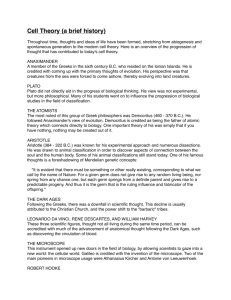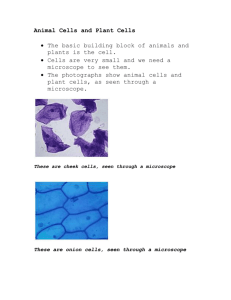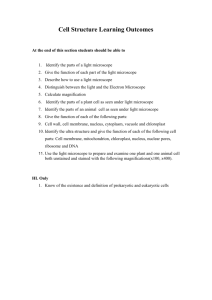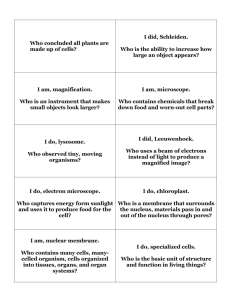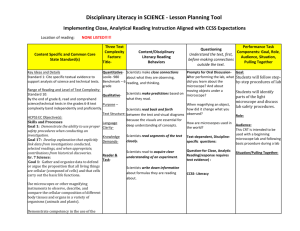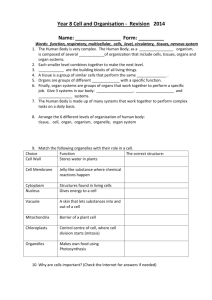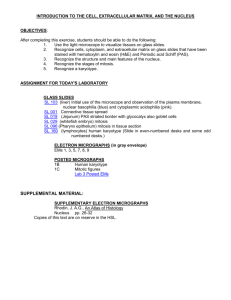Throughout time, thoughts and ideas of life have been formed
advertisement
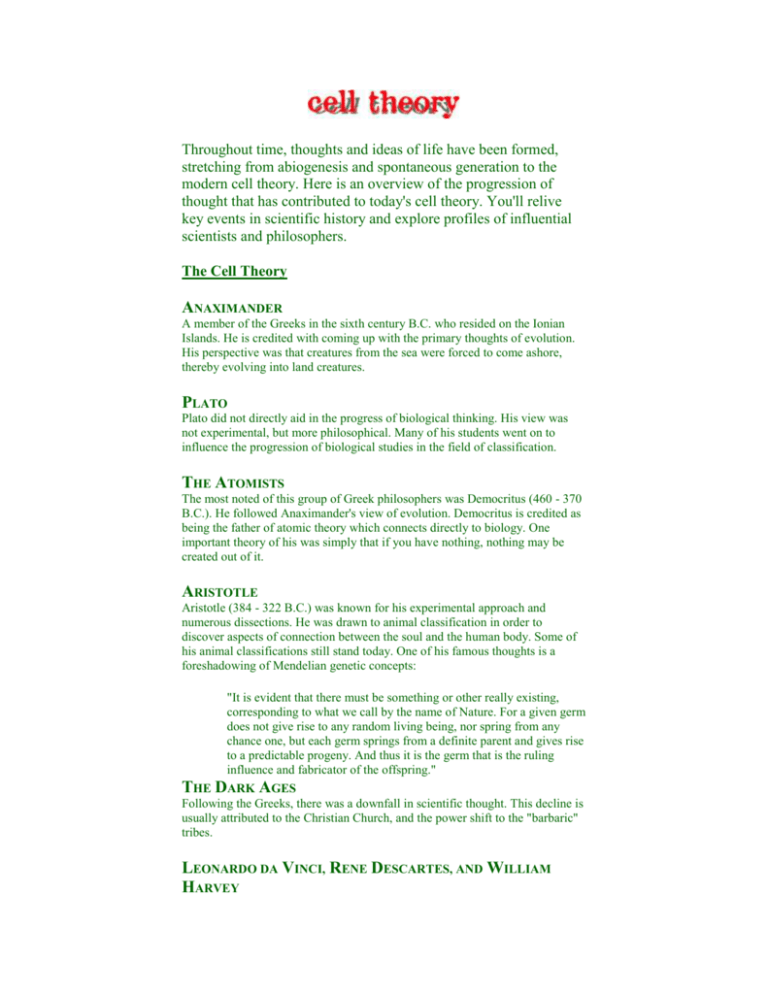
Throughout time, thoughts and ideas of life have been formed, stretching from abiogenesis and spontaneous generation to the modern cell theory. Here is an overview of the progression of thought that has contributed to today's cell theory. You'll relive key events in scientific history and explore profiles of influential scientists and philosophers. The Cell Theory ANAXIMANDER A member of the Greeks in the sixth century B.C. who resided on the Ionian Islands. He is credited with coming up with the primary thoughts of evolution. His perspective was that creatures from the sea were forced to come ashore, thereby evolving into land creatures. PLATO Plato did not directly aid in the progress of biological thinking. His view was not experimental, but more philosophical. Many of his students went on to influence the progression of biological studies in the field of classification. THE ATOMISTS The most noted of this group of Greek philosophers was Democritus (460 - 370 B.C.). He followed Anaximander's view of evolution. Democritus is credited as being the father of atomic theory which connects directly to biology. One important theory of his was simply that if you have nothing, nothing may be created out of it. ARISTOTLE Aristotle (384 - 322 B.C.) was known for his experimental approach and numerous dissections. He was drawn to animal classification in order to discover aspects of connection between the soul and the human body. Some of his animal classifications still stand today. One of his famous thoughts is a foreshadowing of Mendelian genetic concepts: "It is evident that there must be something or other really existing, corresponding to what we call by the name of Nature. For a given germ does not give rise to any random living being, nor spring from any chance one, but each germ springs from a definite parent and gives rise to a predictable progeny. And thus it is the germ that is the ruling influence and fabricator of the offspring." THE DARK AGES Following the Greeks, there was a downfall in scientific thought. This decline is usually attributed to the Christian Church, and the power shift to the "barbaric" tribes. LEONARDO DA VINCI, RENE DESCARTES, AND WILLIAM HARVEY These three scientific figures, thought not all living during the same time period, can be accredited with much of the advancement of anatomical thought following the Dark Ages, such as discovering the circulation of blood. THE MICROSCOPE This instrument opened up new doors in the field of biology, by allowing scientists to gaze into a new world: the cellular world. Galileo is credited with the invention of the microscope. Two of the main pioneers in microscope usage were Athanasius Kircher and Antonie von Leeuwenhoek. ROBERT HOOKE This English naturalist (1635 - 1703) coined the term "cell" after viewing slices of cork through a microscope. The term came from the Latin word cella which means "storeroom" or "small container". He documented his work in the Micrographia, written in 1665. JEAN-BAPTISTE DE LAMARCK The majority of this Frenchman's work (1744 - 1829) dealt with animal classification and evolution. He is credited with taking steps towards the creation of the cell theory with this saying: "Every step which Nature takes when making her direct creations consists in organizing into cellular tissue the minute masses of viscous or mucous substances that she finds at her disposal under favorable circumstances." THE CELL: AN INDIVIDUAL UNIT OF LIFE In 1824, Rene Dutrochet discovered that "the cell is the fundamental element in the structure of living bodies, forming both animals and plants through juxtaposition." However, the first sightings of the internal action of the cell were made by Robert Brown. In Berlin, Johannes Muller created connections between biology and medicine, prompting the connective thinking of his students, such as those of Theodore Schwann. Schwann created the term "cell theory" and declared that plants consisted of cells. This declaration was made after that of Matthias Schlieden's (1804 - 1881) that animals are composed of cells. BIOGENESIS German pathologist Rudolf Virchow (1821 - 1902) altered the thought of cellular biology with his statement that "every cell comes from a cell". Not even twenty years after this statement, processes of cell reproduction were being described--Virchow had completed the thought behind the basic cell theory. A cell is the very smallest unit of living matter. All living things including plants and animals are made up of cells. Cells are made of atoms, which are the smallest units of matter. There are many different kinds of cells. The two kinds you are most likely to be familiar with are animal and plant cells. Some of the differences between them are that plant cells have a cell wall and chloroplasts. Cells all have different sizes, shapes, and jobs to do. Did you know that the yoke from an ostrich's egg is the biggest cell? Even the cells in a single organism may have different shapes, sizes, and jobs. Organisms like humans are made up of trillions of cells. There are also one celled organisms such as euglenas, amoebas, and bacteria. All cells have some parts in common. One part found in all cells is the cell membrane. The cell membrane surrounds the cell, holds the other parts of the cell in place, and protects the cell. Molecules can pass in and out of the cell membrane. Inside the membrane, all cells, except for bacterial cells, contain a nucleus and cytoplasm. The nucleus is a dark structure located in the middle of the cell. It controls the cell's activities, and acts like the cell's brain. Inside the nucleus there is DNA which contains genetic information. The cytoplasm is a jelly-like substance inside the cell where most of the cell's activities take place. It's made out of water and other chemicals. All cell parts, except the nucleus, are located in the cytoplasm. Like all living things, cells die. If you watched a clock for one minute, about three billion cells in your body die. In that same minute, about three billion cells divided so that all the cells that died were replaced. Dead skin cells flake off and dead cells from internal organs will pass through and out of the body with waste products. The length of time cells live can vary. For example, white blood cells only live for thirteen days, red blood cells live for about one hundred and twenty days, liver cells live about eighteen months, and nerve cells can live up to one hundred years. That is a very big difference! Basically, each cell was made from an already existing cell. New cells are made through a process called cell division or mitosis. One cell turns into two cells and then two cells turn into four cells, etc. Even humans started life with only one cell. Most of the cells in many celled organisms use mitosis to reproduce. The animation shows the basic steps in mitosis which are: 1) At the start of mitosis chromosomes are in the nucleus. 2) The chromosomes in the nucleus will then make a copy of themselves 3) Next the cell divides. 4) Last one set of chromosomes goes to the new cell and one set remains in the parent cell. One of the most important tools that scientists use to study cells is the microscope. An optical microscope can magnify a cell up to two thousand times. If an ant were to be magnified at two hundred thousand times, it would be more than two and one half miles (four kilometers) long. Electron microscopes can magnify a cell by one million times. But even with such large magnifications, the very detailed parts of some cells can't be seen. If you would like to see real photographs of cells viewed through the lens of an electron microscope, make sure you visit the Nanoworld Image Gallery (you'll need to register in order to view the gallery). Scientists also put dyes in cells to make certain parts look bright under a microscope. Another way that scientists use to examine cells is to separate them into their parts by using a machine called a centrifuge. It spins substances at really high speeds. First scientists grind up cells in a tube, and then they place the tube in the machine. After whirling around in the centrifuge, the parts of the cell that weigh more sink, while the lighter parts stay on top. That makes it easier for the scientist to study the parts.


